Related Research Articles

Human spaceflight is spaceflight with a crew or passengers aboard a spacecraft, often with the spacecraft being operated directly by the onboard human crew. Spacecraft can also be remotely operated from ground stations on Earth, or autonomously, without any direct human involvement. People trained for spaceflight are called astronauts, cosmonauts (Russian), or taikonauts (Chinese); and non-professionals are referred to as spaceflight participants or spacefarers.

The Space Race was a 20th-century competition between two Cold War rivals, the United States and the Soviet Union, to achieve superior spaceflight capability. It had its origins in the ballistic missile-based nuclear arms race between the two nations following World War II and had its peak with the more particular Moon Race to land on the Moon between the US moonshot and Soviet moonshot programs. The technological advantage demonstrated by spaceflight achievement was seen as necessary for national security and became part of the symbolism and ideology of the time. The Space Race brought pioneering launches of artificial satellites, robotic space probes to the Moon, Venus, and Mars, and human spaceflight in low Earth orbit and ultimately to the Moon.

Splashdown is the method of landing a spacecraft by parachute in a body of water. It was used by crewed American space capsules prior to the Space Shuttle program, by the SpaceX Dragon 1 and Dragon 2 capsules and by NASA's Orion Multipurpose Crew Vehicle. It is also possible for the Russian Soyuz spacecraft to land in water, though this is only a contingency. The only example of an unintentional crewed splashdown in Soviet history is the Soyuz 23 landing.
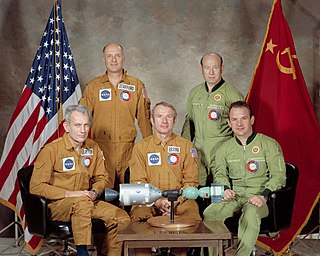
Apollo–Soyuz was the first crewed international space mission, carried out jointly by the United States and the Soviet Union in July 1975. Millions of people around the world watched on television as a United States Apollo spacecraft docked with a Soviet Soyuz capsule. The project, and its handshake in space, was a symbol of détente between the two superpowers during the Cold War.

Soyuz 16 was a December, 1974, crewed test flight for a joint Soviet-United States space flight which culminated in the Apollo–Soyuz mission in July 1975. The two-man Soviet crew, Anatoly Filipchenko and Nikolai Rukavishnikov, tested a docking ring and other systems to be used in the joint flight.

Soyuz 22 was a September, 1976, Soviet crewed spaceflight. It was an Earth sciences mission using a modified Soyuz spacecraft, and was also, some observers speculated, a mission to observe NATO exercises near Norway.
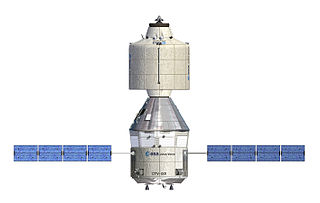
Crew Space Transportation System (CSTS), or Advanced Crew Transportation System (ACTS), was a proposed design for a crewed spacecraft for low Earth orbit operations such as servicing the International Space Station, but also capable of exploration of the Moon and beyond. It was originally a joint project between the European Space Agency (ESA) and the Roscosmos, but later became solely an ESA project. This study was conceived as a basic strategic plan to keep a viable European human spaceflight program alive.

The terms Androgynous Peripheral Attach System (APAS), Androgynous Peripheral Assembly System (APAS) and Androgynous Peripheral Docking System (APDS) are used interchangeably to describe a Russian family of spacecraft docking mechanisms, and are also sometimes used as generic names for any docking system in that family. A system similar to APAS-89/95 is used by the Chinese Shenzhou spacecraft.

Glynn Stephen Lunney was an American NASA engineer. An employee of NASA since its creation in 1958, Lunney was a flight director during the Gemini and Apollo programs, and was on duty during historic events such as the Apollo 11 lunar ascent and the pivotal hours of the Apollo 13 crisis. At the end of the Apollo program, he became manager of the Apollo–Soyuz Test Project, the first collaboration in spaceflight between the United States and the Soviet Union. Later, he served as manager of the Space Shuttle program before leaving NASA in 1985 and later becoming a vice president of the United Space Alliance.

Spaceflight began in the 20th century following theoretical and practical breakthroughs by Konstantin Tsiolkovsky, Robert H. Goddard, and Hermann Oberth. First successful large-scale rocket programs were initiated in Nazi Germany by Wernher von Braun. The Soviet Union took the lead in the post-war Space Race, launching the first satellite, the first man and the first woman into orbit. The United States caught up with, and then passed, their Soviet rivals during the mid-1960s, landing the first men on the Moon in 1969. In the same period, France, the United Kingdom, Japan and China were concurrently developing more limited launch capabilities.
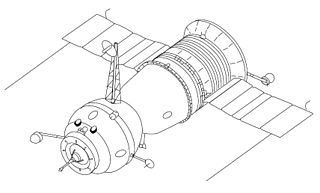
Soyuz 7K-OKS is a version of the Soyuz spacecraft and was the first spacecraft designed for space station flights. Its only crewed flights were conducted in 1971, with Soyuz 10 and Soyuz 11.

The Soyuz-T spacecraft was the third generation Soyuz spacecraft, in service for seven years from 1979 to 1986. The T stood for transport. The revised spacecraft incorporated lessons learned from the Apollo Soyuz Test Project, Soyuz 7K-TM and Military Soyuz.

The 1975 Apollo–Soyuz Test Project version of the Soyuz spacecraft served as a technological bridge to the third generation Soyuz-T spacecraft (1976–1986).
Anatoly Arkadevich Blagonravov was a Soviet engineer in the Soviet space program and later a diplomat. He represented the Soviet Union on the United Nations Committee on the Peaceful Uses of Outer Space (COPUOS). He worked closely with Hugh Dryden, his American counterpart, to promote international cooperation on space projects at the height of the Cold War. Anatoli adopted a dog named Tsygan, one of the first dogs to make a successful sub-orbital flight in 1951. Blagonravov died at the age of 80 in Moscow.

The space policy of the United States includes both the making of space policy through the legislative process, and the implementation of that policy in the United States' civilian and military space programs through regulatory agencies. The early history of United States space policy is linked to the US–Soviet Space Race of the 1960s, which gave way to the Space Shuttle program. At the moment, the US space policy is aimed at the exploration of the Moon and the subsequent colonization of Mars.

Docking and berthing of spacecraft is the joining of two space vehicles. This connection can be temporary, or partially permanent such as for space station modules.
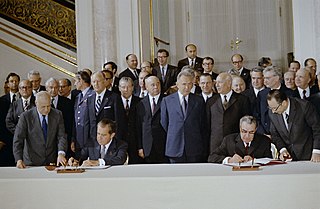
The Moscow Summit of 1972 was a summit meeting between President Richard M. Nixon of the United States and General Secretary Leonid Brezhnev of the Communist Party of the Soviet Union. It was held May 22–30, 1972. It featured the signing of the Anti-Ballistic Missile (ABM) Treaty, the first Strategic Arms Limitation Treaty, and the U.S.–Soviet Incidents at Sea agreement. The summit is considered one of the hallmarks of the détente at the time between the two Cold War antagonists.
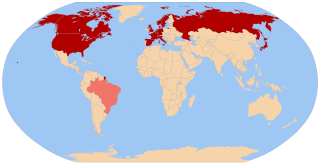
Politics of the International Space Station have been affected by superpower rivalries, international treaties and funding arrangements. The Cold War was an early factor, overtaken in recent years by the United States' distrust of China. The station has an international crew, with the use of their time, and that of equipment on the station, being governed by treaties between participant nations.

"Apollo-Soyuz" was a Soviet brand of cigarettes which were manufactured by the "Java Tobacco Factory" in Moscow, Soviet Union, and Philip Morris USA in the United States. Today it is owned and manufactured by the Krasnodar Tobacco Factory, a Russian subsidiary of Altria.
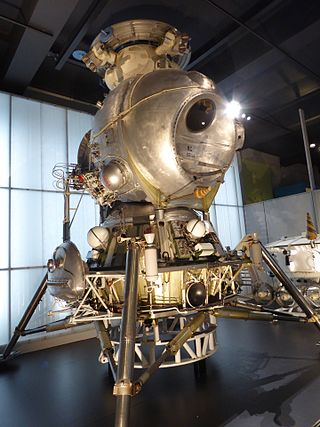
Soyuz Kontakt(Soyuz Contact) was the docking hardware of the Soviet crewed lunar spacecraft program. The Soviet lunar human program was canceled in 1974 after many failures. Four failures of the N-1 Rocket super heavy-lift launch vehicle and the success of the U.S. Apollo program ended the Soviet crewed moon program.
References
- ↑ Muir-Harmony, Teasel (February 27, 2017). "The Space Race and American Foreign Relations". Oxford Research Encyclopedia of American History. doi: 10.1093/acrefore/9780199329175.013.274 . ISBN 978-0-19-932917-5.
- ↑ Wilford, John Noble (April 2, 1972). "Accord With Soviet in Sight On a Joint Space Mission". The New York Times. ISSN 0362-4331 . Retrieved February 23, 2020.
- ↑ "Agreement Concerning Cooperation in the Exploration and Use of Outer Space for Peaceful Purposes" (PDF). U.S. National Archives and Records Administration. May 24, 1972. Retrieved December 13, 2019.
- ↑ "The Partnership - ch6-9". www.hq.nasa.gov. Archived from the original on May 11, 2021. Retrieved February 3, 2020.
- ↑ Wilford, John Noble (April 2, 1972). "Accord With Soviet in Sight On a Joint Space Mission". The New York Times. ISSN 0362-4331 . Retrieved February 22, 2020.
- 1 2 Low, George (April 6, 1972). "VISIT TO MOSCOW, APRIL 1972, TO DISCUSS COMPATIBLE DOCKING SYSTEMS FOR US AND USSR MANNED SPACECRAFT" (PDF). history.nasa.gov. Archived (PDF) from the original on March 18, 2013. Retrieved March 16, 2020.
- ↑ "The Partnership - ch6-11". www.hq.nasa.gov. Archived from the original on January 16, 2023. Retrieved February 3, 2020.